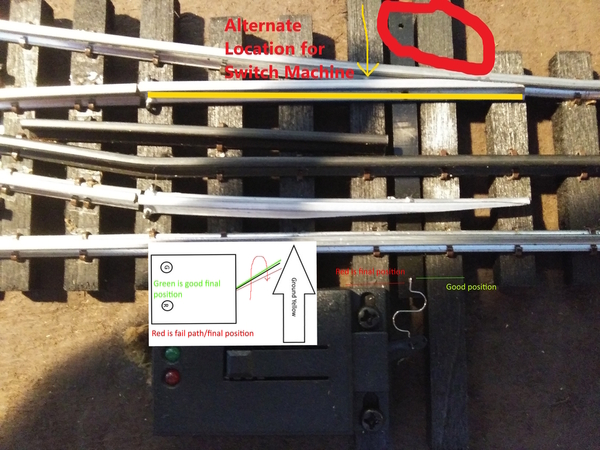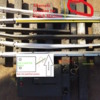In a recent thread discussing the Ross Double Slip Switch with DZ2500s, I related my experience that there was at least two revision levels of the DZ2500. If you turn the DZ2500 over, you will see an approximate 1/4" dot pad. If this dot is silver/solder color, old revision. If this dot is gold tone, newer version.
I also related that I was able to replace the old version to new version for with Dennis Zander of Z Stuff for Trains at a cost of $8 per DZ2500, and I exchanged about a dozen. @gunrunnerjohn just reported that the cost is now $25 per DZ2500.
This drastic cost increase has prompted me to write this post trying to describe the problem I experienced with the older version in hopes that you may be able to test any older versions you have before doing the now more costly exchange.
Below is reference pic for my explanation
This is a Ross switch with DZ2500. The white block I pasted onto the pic shows which switching direction the DZ2500 failed in, never failed in the opposite switching direction (Sad to say I am relying on my memory about which direction fails, but DZ2500 only failed in one direction). I refer to the part of the DZ2500 that moves as the "arm". When the arm moves as shown, from Red LED side to Green LED side, the arm is supposed to transverse, stop, keeping spring tension on the points - tried to show good final arm position with green line on white block, and final spring position with a green line by the spring.
On a failed switching, the arm does a full transversal as a good switching, the backs up a bit. Tried to depict final position of the arm with the red line on the white block, and a red arrow trying to show that arm fully transverses, then backs up. Likewise, I tried to show the final spring position with a red line by the spring. This backwards motion does not open a gap between points and fixed rail, BUT it does remove the spring tension keeping points tightly against fixed rail. Thus, if you gently push against the points as shown by a yellow arrow, the points will move to the thick yellow line position, opening a gap, which remains after removing your gentle push.
The lack of spring tension, but points against fixed rail, can work, but can start to open with vibration of passing trains, how wheel flanges hit the end of the points, which direction your going, etc., eventually leading to derailment.
I should mention that I was not able to adjust the DZ2500 position to keep the spring tension on a failed switch - if I got the failed switching direction to keep tension, the good switching direction would not have spring tension any more.
The arm's slight backup is visible to the eye, but I feel the better test is to switch, apply the gently pressure to the points to see if the gap opens and remains open.
I hope this gives you a better idea of what I saw as a failure with the older version of the DZ2500. If you do decide to exchange, make sure you send a controller with the DZ2500, or Dennis will charge for the controller also.
I have not seen this type of fail with the gold tone dot newer version of the DZ2500.









